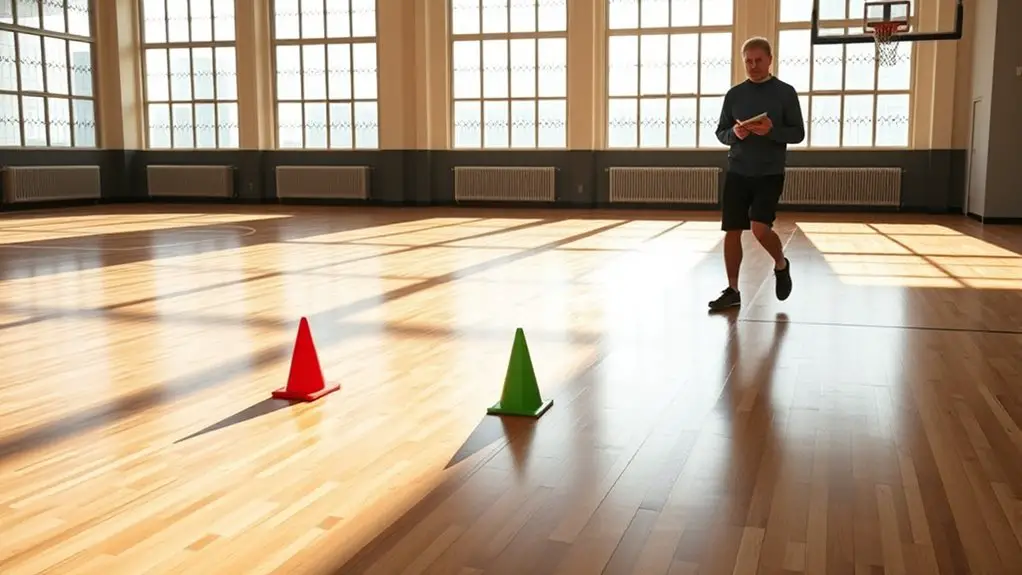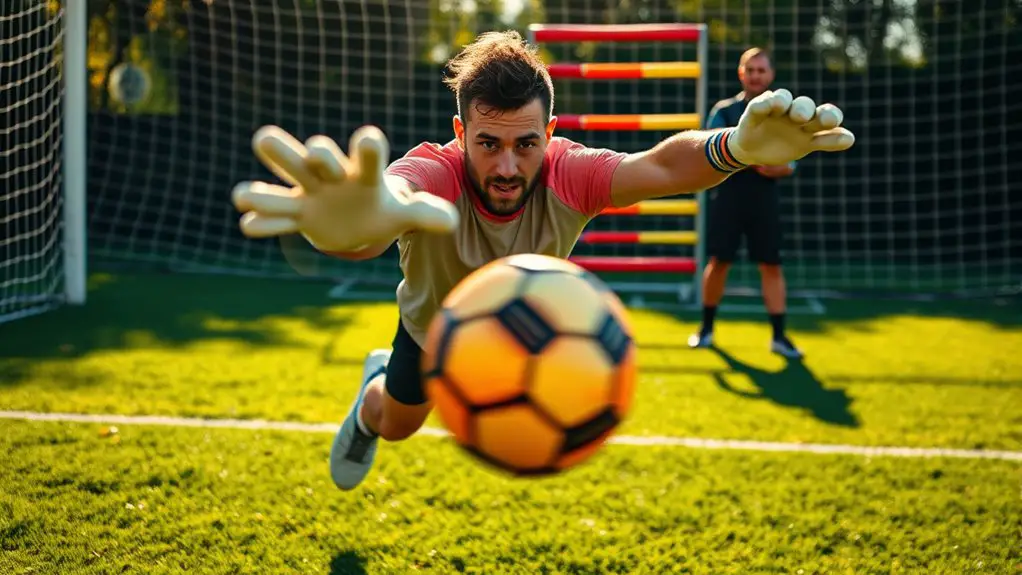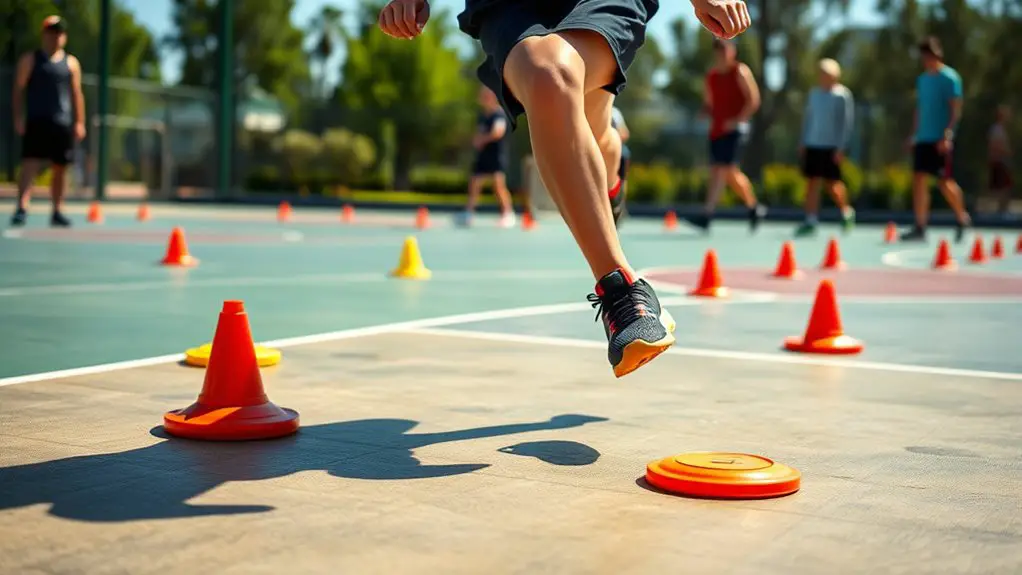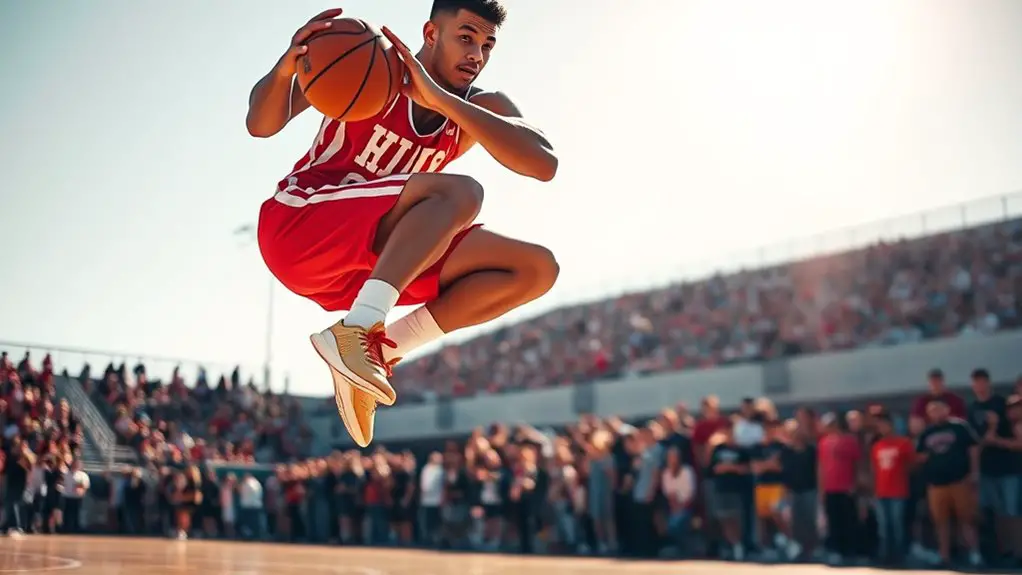To achieve elite-level movement, you need a mix of footwork drills. Start with ladder drills for quickness and cone drills to sharpen directional changes. Incorporate jump rope exercises to enhance rhythm and coordination. Shadowing drills will boost your reaction time, while plyometric exercises build explosive power. Don't forget agility hurdles and T-drills for acceleration and deceleration training. Partner drills can add a competitive edge. Keep going to discover even more techniques that can elevate your performance!
Ladder Drills for Quickness
Ladder drills are a fantastic way to boost your quickness and agility on the field or court. By mastering various ladder patterns, you'll enhance your foot placement, allowing you to move more freely and efficiently. Start with simple patterns, like the one-foot in and out, then progress to more complex sequences like the lateral shuffle or crossover step. These drills not only sharpen your foot speed but also improve your coordination and balance.
As you practice, pay attention to your foot placement—keep your feet light and quick, ensuring they land softly within the rungs. This focus on precision will help you develop a natural rhythm, making your movements feel more fluid. Regularly incorporating ladder drills into your training regimen will empower you to break free from limitations, giving you that extra edge needed to outperform your competition. Embrace the freedom of movement and watch your agility soar! Additionally, these drills can be tailored to various skill levels, ensuring that athletes at any stage can benefit from them.
Cone Drills for Directional Change
While quickness is essential, being able to change direction effectively can be just as important in sports. Cone drills are a fantastic way to enhance your agility and sharpen your directional changes. Start by setting up your agility cones in various patterns, such as zigzags or T-shapes, to challenge yourself. Focus on your cone placement; the distance between cones can affect your speed and control.
When you sprint toward a cone, practice planting your foot firmly and pivoting sharply to the next cone. This mimics real-game scenarios where you need to dodge opponents or shift quickly. As you improve, try adding more cones or decreasing the distance between them to up the intensity. Remember, the more you commit to these drills, the more freedom you'll have on the field. Additionally, incorporating sport-specific footwork drills will further enhance your effectiveness during critical plays. So grab those agility cones and get started; your directional skills are about to take off!
Jump Rope for Rhythm and Coordination
After honing your agility with cone drills, jump rope training can take your footwork to the next level by improving your rhythm and coordination. Incorporating various jump rope techniques into your routine can enhance your overall athleticism, allowing you to move with freedom and fluidity. Strength training plays a crucial role in enhancing your muscle power for directional changes as you develop your footwork.
Here's a simple table to get you started on your rhythm training:
| Jump Rope Technique | Benefits |
|---|---|
| Basic Bounce | Builds coordination |
| Single Leg Jumps | Improves balance |
| Criss-Cross | Enhances agility |
| Double Unders | Increases power output |
Experiment with these techniques, and watch how they transform your footwork. By jumping rope regularly, you'll not only develop a solid rhythm but also improve your timing and overall movement efficiency. So grab that rope and release your potential!
Shadowing Drills for Reaction Time
To elevate your footwork even further, incorporating shadowing drills into your training routine can greatly boost your reaction time. These drills let you mimic an opponent's movements, sharpening your ability to respond quickly and effectively. Start by using shadowing techniques with a partner who'll move unpredictably. You'll react to their movements, focusing on foot placement and speed.
As you progress, increase the intensity by adding reaction drills that involve sudden changes in direction. This will enhance your agility and help you develop a natural sense of timing. Don't forget to mix in variations like lateral shuffles or quick steps to keep things fresh and engaging. Additionally, practicing mental conditioning techniques can further improve your responsiveness during these drills.
Plyometric Exercises for Explosive Power
Plyometric exercises are key for developing explosive power, and you'll want to focus on techniques like box jumps. Understanding the benefits of depth jumps can enhance your performance, while mastering the mechanics of lateral bounds can improve your agility. Additionally, these exercises leverage the stretch-shortening cycle of muscles to maximize your explosive potential. Let's explore how these exercises can elevate your footwork and overall athleticism.
Box Jumps Techniques
Box jumps can elevate your explosive power and overall athletic performance when executed with proper technique. Start with a controlled box jump progression, beginning at a lower height to master your form. Stand tall, engage your core, and focus on a powerful jump, landing softly with your knees slightly bent. This not only enhances your strength but also boosts your agility. Remember, box jump safety is essential—ensure the box is stable and clear of obstacles. As you gain confidence, gradually increase the height. This will challenge your muscles and improve your explosiveness. Embrace the freedom of movement and push your limits, but always prioritize safety for sustainable gains. Consistent practice will lead to remarkable improvements in your athleticism.
Depth Jumps Benefits
After mastering box jumps, incorporating depth jumps into your routine can greatly enhance your explosive power. These plyometric exercises are all about maximizing your potential. When you step off a platform and land, your muscles experience a stretch reflex, allowing for a powerful rebound. This dynamic movement not only improves your vertical leap but also boosts overall athletic performance. You'll notice quicker acceleration and improved agility, essential for any sport. Plus, depth jumps help build strength in your lower body, enhancing your ability to generate explosive force. By regularly including depth jumps in your training, you're setting yourself up for significant performance enhancement, ultimately giving you more freedom and confidence in your movements. Go ahead, elevate your game!
Lateral Bounds Mechanics
While you might be familiar with explosive movements, lateral bounds offer a unique way to improve your agility and power. This plyometric exercise focuses on lateral movement, allowing you to develop an explosive push off the ground. Here's how to maximize your lateral bounds:
- Starting Position: Stand on one leg, with your opposite knee slightly bent, ready to push off explosively.
- Movement: Leap sideways, driving your opposite knee up and swinging your arms for momentum, landing softly on the opposite leg.
- Balance and Control: Focus on maintaining balance upon landing, absorbing the impact while preparing for the next bound.
Incorporate these mechanics into your routine, and you'll reveal new levels of athletic freedom and performance!
Agility Hurdles for Heightened Foot Speed
Agility hurdles are an excellent tool for enhancing foot speed and overall agility. By incorporating them into your training routine, you can experience a liberating sense of movement as you navigate through the hurdles with ease. Start with basic foot speed variations, like quick steps over each hurdle, then progress to more complex patterns.
Combine agility ladder techniques with hurdle drills for a dynamic workout that challenges your coordination and rhythm. For instance, you can perform lateral movements between hurdles, focusing on maintaining a light, agile touch.
As you practice, you'll notice how your body adapts, allowing for faster reactions and improved footwork. Embrace the freedom that comes with heightened agility, and let the hurdles guide you to new levels of performance. With consistency, you'll find yourself flying over hurdles and feeling more empowered in your movements, whether on the field or court. Additionally, incorporating agility training into your routine will further enhance your overall game performance.
T-Drills for Acceleration and Deceleration
Building on the agility you've developed with hurdles, T-drills are a fantastic way to enhance your acceleration and deceleration skills. These drills challenge your body to respond quickly, helping you master essential acceleration techniques. Here's how to get the most out of your T-drills:
T-drills are an excellent way to boost your acceleration and deceleration, enhancing your agility and responsiveness on the field or court.
- Standard T-Drill: Sprint to the middle cone, shuffle to the side cones, then backpedal to the start. This variation focuses on quick changes in direction.
- T-Drill with Backpedal: After reaching the end, add a backpedal to enhance your deceleration capabilities.
- T-Drill Variations with Resistance: Use a resistance band or weighted vest to increase intensity, pushing your limits further.
Incorporating these variations into your routine will not only improve your footwork but also give you the freedom to move fluidly on the field or court. As you train, remember that mobility training is essential for reducing injury risk and enhancing your overall athletic performance. Embrace the challenge, and watch your skills soar!
Partner Drills for Competitive Edge
When you train with a partner, you not only push each other to improve but also simulate the competitive situations you'll face in games. Partner drills emphasize partner communication and cultivate a competitive mindset, essential for real-world performance. Here are some effective drills you can try:
| Drill Name | Focus Area | Key Benefits |
|---|---|---|
| Mirror Drill | Agility & Reaction | Quick decision-making |
| Tag Drill | Speed & Evasion | Enhances lateral movement |
| Partner Pass | Coordination | Boosts teamwork skills |
| Shadow Drill | Footwork Precision | Improves movement mechanics |
Incorporating these drills into your routine will help you develop the skills needed to outmaneuver opponents. Remember, it's all about fostering that competitive edge and enjoying the journey together! Additionally, practicing mindfulness techniques can enhance your focus during these drills, allowing for better performance in competitive scenarios.
Frequently Asked Questions
How Often Should I Incorporate Footwork Drills Into My Training Schedule?
You should aim to incorporate footwork drills into your training schedule about two to three times a week. This frequency allows you to build consistency without feeling overwhelmed. Listen to your body and adjust as needed; it's all about finding that balance. Remember, the freedom to modify your routine can enhance your overall performance. Prioritize these drills to sharpen your movement and make your training sessions feel more rewarding and effective.
Can Footwork Drills Improve My Performance in Other Sports?
Absolutely, footwork drills can greatly enhance your performance in other sports. The benefits of improved footwork translate into better agility, balance, and coordination, which are essential for nearly any athletic endeavor. Whether you're playing basketball, soccer, or tennis, sport-specific applications of footwork can give you that edge. By incorporating these drills into your routine, you'll find yourself moving more freely and efficiently, allowing for quicker reactions and better overall performance on the field or court.
What Is the Ideal Warm-Up Before Footwork Drills?
Before diving into footwork drills, it's essential you warm up properly. Start with dynamic stretches to loosen up your muscles and increase your range of motion. Think leg swings and arm circles. Then, incorporate agility exercises like ladder drills or cone sprints to get your heart rate up and sharpen your coordination. This preparation not only enhances your performance but also helps prevent injuries, giving you the freedom to move confidently.
How Can I Track My Progress in Footwork Drills?
To track your progress in footwork drills, you can use video analysis to observe your technique over time. Record your sessions and review them to spot improvements or areas needing work. Combine this with performance metrics, like speed and accuracy, to measure your growth. Setting personal goals based on your findings can help you maintain a sense of freedom in your training while pushing yourself to achieve even better results.
Are There Any Common Mistakes to Avoid During Footwork Drills?
When you're working on footwork drills, it's essential to avoid common errors that can hinder your progress. Watch out for technique flaws, like overstriding or losing balance, as they can limit your effectiveness. Make sure you're maintaining proper posture and engaging your core. If you focus on these aspects, you'll find more freedom in your movement. Remember, it's all about refining those basics to elevate your overall performance.




